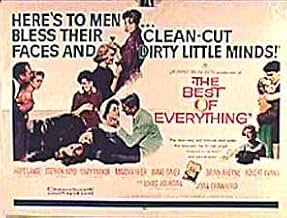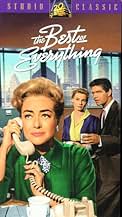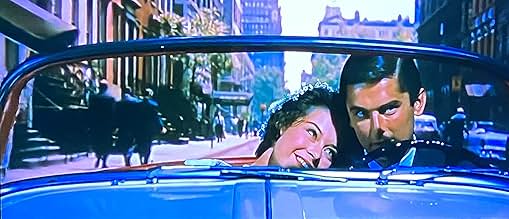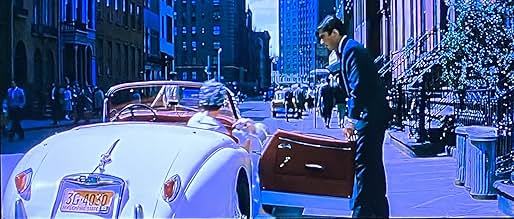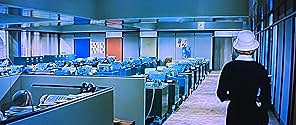IMDb RATING
6.6/10
2.5K
YOUR RATING
An expose of the lives and loves of Madison Avenue working girls and their higher ups.An expose of the lives and loves of Madison Avenue working girls and their higher ups.An expose of the lives and loves of Madison Avenue working girls and their higher ups.
- Nominated for 2 Oscars
- 2 nominations total
Linda Hutchins
- Jane
- (as Linda Hutchings)
Ted Otis Sr.
- Dr. Ronnie Wood
- (as Ted Otis)
Gertrude Astor
- Leading Woman in Play
- (uncredited)
Alan Austin
- Bill
- (uncredited)
Joseph Bardo
- Policeman
- (uncredited)
Featured reviews
Meant to be a glossy romance and cautionary tale for girls who dare to think of working Outside The Home, "The Best of Everything" instead is a virtual primer of the root causes of the modern Women's movement: Women (really, girls) can have jobs, but only until they find a man and leave to begin their real lives as homemakers; women are sexual toys, provided to men at work for their amusement; all men are predators and all women are fools; pregnancy is entirely the woman's fault; women who take their jobs seriously are damaged people; women merely exist for the use of men. Sounds like an unremitting screed, and it is -- yet, such is Hollywood's power, the pageant is very watchable (the clothes, the sentimental views of 1959 NYC) and beautiful. A wonderful snapshot of America just a couple of years before "The Feminine Mystique" was published. Must-see for women.
Claire Booth Luce's "The Women" shows relationships with men through a woman's point of view in a play, (and 1939 film that also has Joan Crawford playing a bitch: a character who might have been Amanda Farrow 20 years before), that has no male characters. Here we see the male characters and what a bunch they are. They use women like toys and throw them away, leaving the women to suffer. Ironically, the women in "The Women", perhaps because they are all we see, are shown in a less than favorable light, alternately silly and scheming, with the only "nice" one, (Norma Shearer), growing "claws" by the end. In "The Best of Everything" we see the men for the cads they are while the women are largely innocent and vulnerable.
This is a film about women leaping from things. Diane Baker leaps from a car, (in perhaps the most absurd scene in cinema history, which is not in the book). Suzy Parker falls from a fire escape. The women in the film are leaping into the workplace, looking for success and love at the same time. Women would leap into the future and leave this type of soap opera behind in the next decade. But they would come back to it in the 80's and 90's through the novels of people like Sidney Sheldon and Judith Krantz, (although their trashier works aren't as good as this).
The best thing about this film is the way it looks. I love the glossy cinemascope films of the 50's and 60's. They look so much better than the pixel-challenged home movies we've been making since, especially in the letterboxed version we see on TV, and the DVD, with the picture so clear you could walk into it. The look of the bevy of young beauties in it is also memorable. This film probably has more beautiful women in it than any other. It has a supermodel, (Suzy Parker), a beauty queen, (Myrna Hansen, who was not Miss America 1954 as Rona Jaffe says in the DVD commentary but rather Miss USA 1953, per the IMDb: but so what), and a Playboy playmate, (June Blair, from January 1957). My vote goes to Suzy, one of the astonishing beauties of all time. Her acting here isn't as awful as people pretend: they are just reacting, as people did then, to the sight of a supermodel, (the first, really), trying to act. Nobody seemed to care how well she did. Her role, that of an apparently worldly woman who turns out to be the most vulnerable, is the most complex in the bunch and she does just fine.
The most touching thing about the film now is the age of the female leads at the time. Hope Lange was 27 when they filmed this in the spring of 1959. Diane Baker was 20. Suzy Parker was 26. Hope, who looked to be Grace Kelly's heir, never made it really big and wound up being Mrs. Muir on television and, per the IMDb, wound up living in a home with "crates for coffee tables" because she spent her money on causes she believed in before dying at age 72 in 2003. This film must have seemed a very distant and irrelevant memory to her by then. Baker, always a welcome face in 60's TV, (especially to Richard Kimble), and still active as an actress and acting coach, just turned 67. Parker found "the best of everything" with Bradford Dillman for 40 years before dying at age 70 the same year Lange did. But here they are, young, beautiful and ambitious for success and love, just like their characters.
This is a film about women leaping from things. Diane Baker leaps from a car, (in perhaps the most absurd scene in cinema history, which is not in the book). Suzy Parker falls from a fire escape. The women in the film are leaping into the workplace, looking for success and love at the same time. Women would leap into the future and leave this type of soap opera behind in the next decade. But they would come back to it in the 80's and 90's through the novels of people like Sidney Sheldon and Judith Krantz, (although their trashier works aren't as good as this).
The best thing about this film is the way it looks. I love the glossy cinemascope films of the 50's and 60's. They look so much better than the pixel-challenged home movies we've been making since, especially in the letterboxed version we see on TV, and the DVD, with the picture so clear you could walk into it. The look of the bevy of young beauties in it is also memorable. This film probably has more beautiful women in it than any other. It has a supermodel, (Suzy Parker), a beauty queen, (Myrna Hansen, who was not Miss America 1954 as Rona Jaffe says in the DVD commentary but rather Miss USA 1953, per the IMDb: but so what), and a Playboy playmate, (June Blair, from January 1957). My vote goes to Suzy, one of the astonishing beauties of all time. Her acting here isn't as awful as people pretend: they are just reacting, as people did then, to the sight of a supermodel, (the first, really), trying to act. Nobody seemed to care how well she did. Her role, that of an apparently worldly woman who turns out to be the most vulnerable, is the most complex in the bunch and she does just fine.
The most touching thing about the film now is the age of the female leads at the time. Hope Lange was 27 when they filmed this in the spring of 1959. Diane Baker was 20. Suzy Parker was 26. Hope, who looked to be Grace Kelly's heir, never made it really big and wound up being Mrs. Muir on television and, per the IMDb, wound up living in a home with "crates for coffee tables" because she spent her money on causes she believed in before dying at age 72 in 2003. This film must have seemed a very distant and irrelevant memory to her by then. Baker, always a welcome face in 60's TV, (especially to Richard Kimble), and still active as an actress and acting coach, just turned 67. Parker found "the best of everything" with Bradford Dillman for 40 years before dying at age 70 the same year Lange did. But here they are, young, beautiful and ambitious for success and love, just like their characters.
Caroline Bender (Hope Lange) is just killing time getting a job. Her real ambition is to marry Eddie and have a baby.
April (Diane Baker) is too innocent to stay that way for long and falls in love too easily, a dangerous combo.
Greg (Suzy Parker) is a go-getter and wants to be an actress.
All three are doomed for dramatics in 'The Best of Everything', a 1959 soap opera/morality play/sometimes solid movie that is aging by the second.
Set in the cut-throat world of paperback publishing, its not as trashy as "Valley of the Dolls" but not as vanilla as "Three Coins in the Fountain."
The men in the mix - Brian Aherne, Stephen Boyd, Louis Jourdan and Robert Evans - are slick, well-dressed and no good, for the most part. Aherne is the resident sexual offender - will pinch anything walking by, and makes unwanted advances right and left. His character is offensive as hell, but its not played seriously at all. Harassment hadn't been discovered yet, I guess. Boyd works there, too, although you never see him actually doing anything. He's too busy being older, wiser and drunker. Evans is abroad just so Diane Baker can suffer in style - he's a rich kid who's gotten her in 'trouble' so instead of marrying her, as promised, he's taking her to get an 'operation.'
Jourdan is a director who mistakenly has an affair with Parker. They share a fight scene which is fairly no-holds barred, in a movie like this anyway, but the scene is ultimately ruined by Parker's histronics. She ends up nearly stalking him, and she really didn't deserve such a lousy fate, her bad acting notwithstanding.
Joan Crawford breathes fire as Amanda Farrow, the resident 'witch' who is automatically rude and dismissive of any of her legion of secretaries. Well they are younger, aren't they? Isn't that sufficient reason to hate a person? Caroline doesn't think so, as she admirably stands up to Miss Farrow every chance she gets. Crawford only gets to let loose once, when she tells her married boyfriend 'you can your rabbit-faced wife can both go to hell' and slams down the phone. You never get to see the poor soul who dare crosses her.
Martha Hyer's 'storyline', as it were, is extremely weak, and she is painfully over-the-top as an unmarried mother. Short of wearing a huge "W" (for 'whore') on her cardigan, she walks around like a pathetic mess for most of her screen time. Even worse, she is not given the courtesy of having it all 'tied up', one way or the other, at the end. It won't matter that much, but still..
Its painfully obvious this all took place in a totally different world. People were nicer to one another for the most part and work was not a drag but something exciting, for a girl from outside NYC anyway.
One unconvincing drunk scene aside, Hope Lange helps it seem reasonably real as Caroline, who at least has more than one side to her character.
I admire that women are seen having an opinion, a chance and a choice. Not that its not wrapped in a nice bow, but it makes some points for equality. In 1959 that was probably noteworthy and possibly controversial. 7/10.
April (Diane Baker) is too innocent to stay that way for long and falls in love too easily, a dangerous combo.
Greg (Suzy Parker) is a go-getter and wants to be an actress.
All three are doomed for dramatics in 'The Best of Everything', a 1959 soap opera/morality play/sometimes solid movie that is aging by the second.
Set in the cut-throat world of paperback publishing, its not as trashy as "Valley of the Dolls" but not as vanilla as "Three Coins in the Fountain."
The men in the mix - Brian Aherne, Stephen Boyd, Louis Jourdan and Robert Evans - are slick, well-dressed and no good, for the most part. Aherne is the resident sexual offender - will pinch anything walking by, and makes unwanted advances right and left. His character is offensive as hell, but its not played seriously at all. Harassment hadn't been discovered yet, I guess. Boyd works there, too, although you never see him actually doing anything. He's too busy being older, wiser and drunker. Evans is abroad just so Diane Baker can suffer in style - he's a rich kid who's gotten her in 'trouble' so instead of marrying her, as promised, he's taking her to get an 'operation.'
Jourdan is a director who mistakenly has an affair with Parker. They share a fight scene which is fairly no-holds barred, in a movie like this anyway, but the scene is ultimately ruined by Parker's histronics. She ends up nearly stalking him, and she really didn't deserve such a lousy fate, her bad acting notwithstanding.
Joan Crawford breathes fire as Amanda Farrow, the resident 'witch' who is automatically rude and dismissive of any of her legion of secretaries. Well they are younger, aren't they? Isn't that sufficient reason to hate a person? Caroline doesn't think so, as she admirably stands up to Miss Farrow every chance she gets. Crawford only gets to let loose once, when she tells her married boyfriend 'you can your rabbit-faced wife can both go to hell' and slams down the phone. You never get to see the poor soul who dare crosses her.
Martha Hyer's 'storyline', as it were, is extremely weak, and she is painfully over-the-top as an unmarried mother. Short of wearing a huge "W" (for 'whore') on her cardigan, she walks around like a pathetic mess for most of her screen time. Even worse, she is not given the courtesy of having it all 'tied up', one way or the other, at the end. It won't matter that much, but still..
Its painfully obvious this all took place in a totally different world. People were nicer to one another for the most part and work was not a drag but something exciting, for a girl from outside NYC anyway.
One unconvincing drunk scene aside, Hope Lange helps it seem reasonably real as Caroline, who at least has more than one side to her character.
I admire that women are seen having an opinion, a chance and a choice. Not that its not wrapped in a nice bow, but it makes some points for equality. In 1959 that was probably noteworthy and possibly controversial. 7/10.
The Best of Everything is a high gloss large screen soap opera which follows the careers of four career women, Hope Lange, Suzy Parker, Diane Baker, and Martha Hyer at a New York publishing firm. What's the best for some women is not necessarily the best for all.
Presiding over this group of young fillies is wise old mare Joan Crawford who's been around the track a few times on screen and in real life. She looks right at home as the boss lady as well she should have at this point.
Around the time she was making The Best of Everything Joan Crawford became a widow when her fourth husband, Alfred Steele died. It was a particularly traumatic event for her, she woke up one morning and found him dead in bed next to her. She inherited all of his stock in Pepsi Cola where he was the board chairman and during the same period as The Best of Everything was being made, she wound up the queen bee at Pepsi Cola. Life does sometimes imitate art. So that authority as she barks out dictation and coffee orders to Hope Lange rings real true.
In fact all the women here with the exception of Lange are in for some rough sledding. It's rough for Lange too, but she literally makes the best of everything.
What a collection of stinkers the men are in this film. The best of them, Stephen Boyd, is a heavy drinker. The others Louis Jourdan, Robert Evans, and Brett Halsey, are as slimy a collection of rodents as ever gathered for one film.
I can't forget Brian Aherne either who's the fanny pinching head of this publishing firm. Half that office would have sexual harassment suits going today.
Some nice location shots of New York in the fifties make the film a real treat. Catch it by all means.
Presiding over this group of young fillies is wise old mare Joan Crawford who's been around the track a few times on screen and in real life. She looks right at home as the boss lady as well she should have at this point.
Around the time she was making The Best of Everything Joan Crawford became a widow when her fourth husband, Alfred Steele died. It was a particularly traumatic event for her, she woke up one morning and found him dead in bed next to her. She inherited all of his stock in Pepsi Cola where he was the board chairman and during the same period as The Best of Everything was being made, she wound up the queen bee at Pepsi Cola. Life does sometimes imitate art. So that authority as she barks out dictation and coffee orders to Hope Lange rings real true.
In fact all the women here with the exception of Lange are in for some rough sledding. It's rough for Lange too, but she literally makes the best of everything.
What a collection of stinkers the men are in this film. The best of them, Stephen Boyd, is a heavy drinker. The others Louis Jourdan, Robert Evans, and Brett Halsey, are as slimy a collection of rodents as ever gathered for one film.
I can't forget Brian Aherne either who's the fanny pinching head of this publishing firm. Half that office would have sexual harassment suits going today.
Some nice location shots of New York in the fifties make the film a real treat. Catch it by all means.
Although dated, this film is definitely worth a watch. I saw it about eight times as a teenager when it opened and it changed my life...I just HAD to live in New York. It has great opening shots of the Manhattan skyline with Johnny Mathis crooning "Romance is still...the best of everything..." that rival those of West Side Story. There is a rather stilted performance by the world's REAL first Supermodel, Suzy Parker (sorry about that, Janice D.), but it's great eye-candy! It also offers a bit of insight into late 1950's American mores--our obsession with (and repression of) sex (in the workplace, no less!), romance, and marriage before women's lib. It represents an era in which New York was at it's finest and a super-bitchy performance by Joan Crawford is just the icing on the cake.
Did you know
- TriviaJoan Crawford, recently elected to the board of directors of Pepsi after the death of her husband who had been President and CEO of the company, managed to swing a brief quasi product plug for the soft drink by having an unmistakable Pepsi machine (with the red, white, and blue Pepsi logo, but sans the word "Pepsi") installed in the secretaries' on-screen break room.
- GoofsIn the scene when Diane Baker tells Hope Lange "he's ten foot tall to me" while walking down the street, several people... two men and two young boys... look into the camera, smiling (they were obviously filming with a camera hidden in a car during these scenes as those people weren't extras).
- Quotes
Amanda Farrow: Now you and your rabbit-faced wife can both go to hell!
- ConnectionsFeatured in Playboy's Penthouse: Episode #1.1 (1959)
- SoundtracksThe Best of Everything
by Sammy Cahn and Alfred Newman
Johnny Mathis sings during the opening credits
Also sung by a chorus at the end
Played often in the score
- How long is The Best of Everything?Powered by Alexa
Details
Box office
- Budget
- $2,500,000 (estimated)
- Runtime2 hours 1 minute
- Color
- Aspect ratio
- 2.35 : 1
Contribute to this page
Suggest an edit or add missing content



